Plague and People: Examining the Black Death's Historical Context
VerifiedAdded on 2023/04/21
|6
|1381
|236
Essay
AI Summary
This essay examines the Black Death, a devastating pandemic that swept through Europe in the mid-14th century, causing over 20 million deaths. It details the disease's origins, thought to be caused by the Yersina pestis bacterium, and its transmission through infected rats and fleas. The essay explores the different forms of the plague, including bubonic, septic, and pneumonic, and their impact on the lymphatic system and bloodstream. It further analyzes the profound effects of the Black Death on European culture and society, including economic consequences like labor shortages and inflation, changes in religious beliefs, and social isolation. The essay concludes by emphasizing the massive impact of the plague and its complex biological and societal consequences.
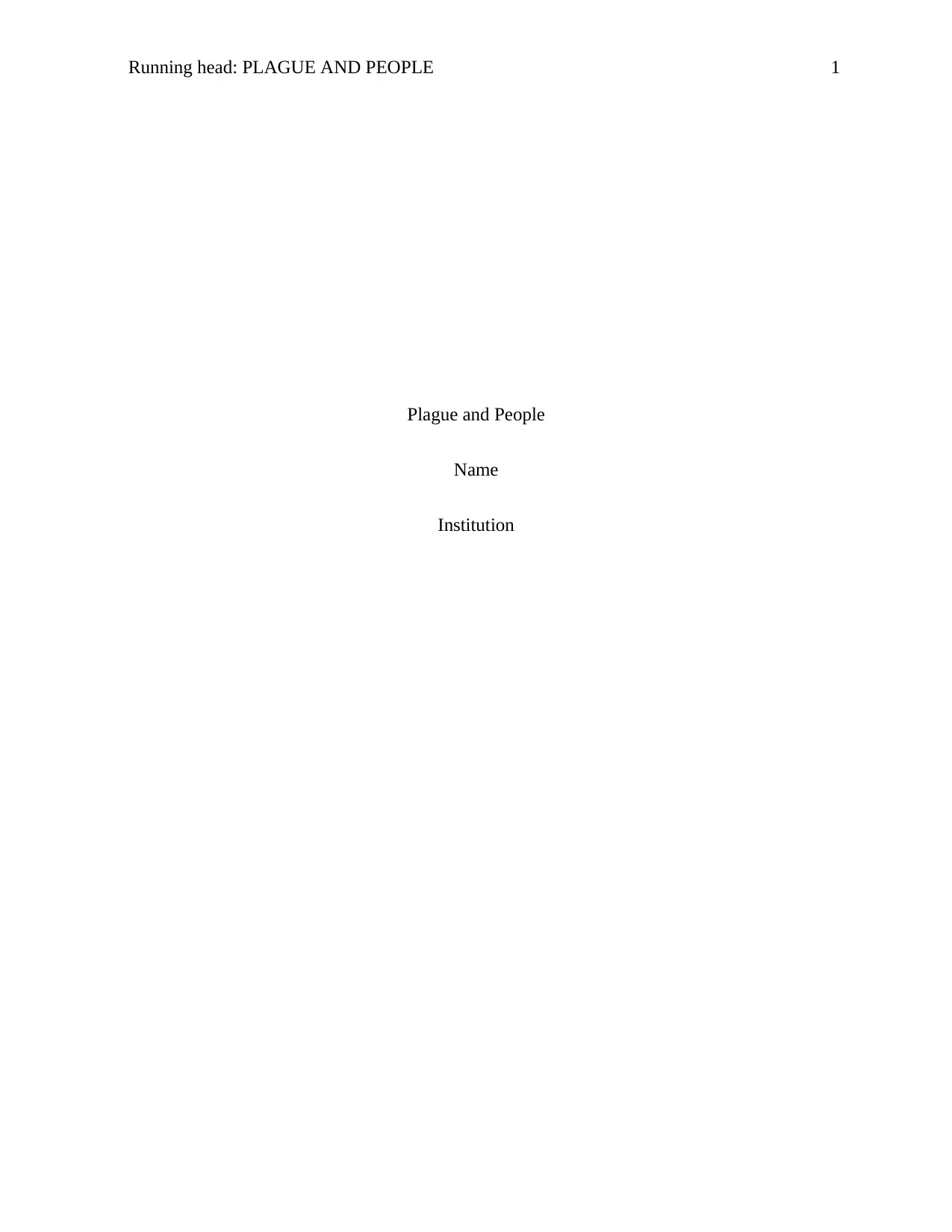
Running head: PLAGUE AND PEOPLE 1
Plague and People
Name
Institution
Plague and People
Name
Institution
Paraphrase This Document
Need a fresh take? Get an instant paraphrase of this document with our AI Paraphraser
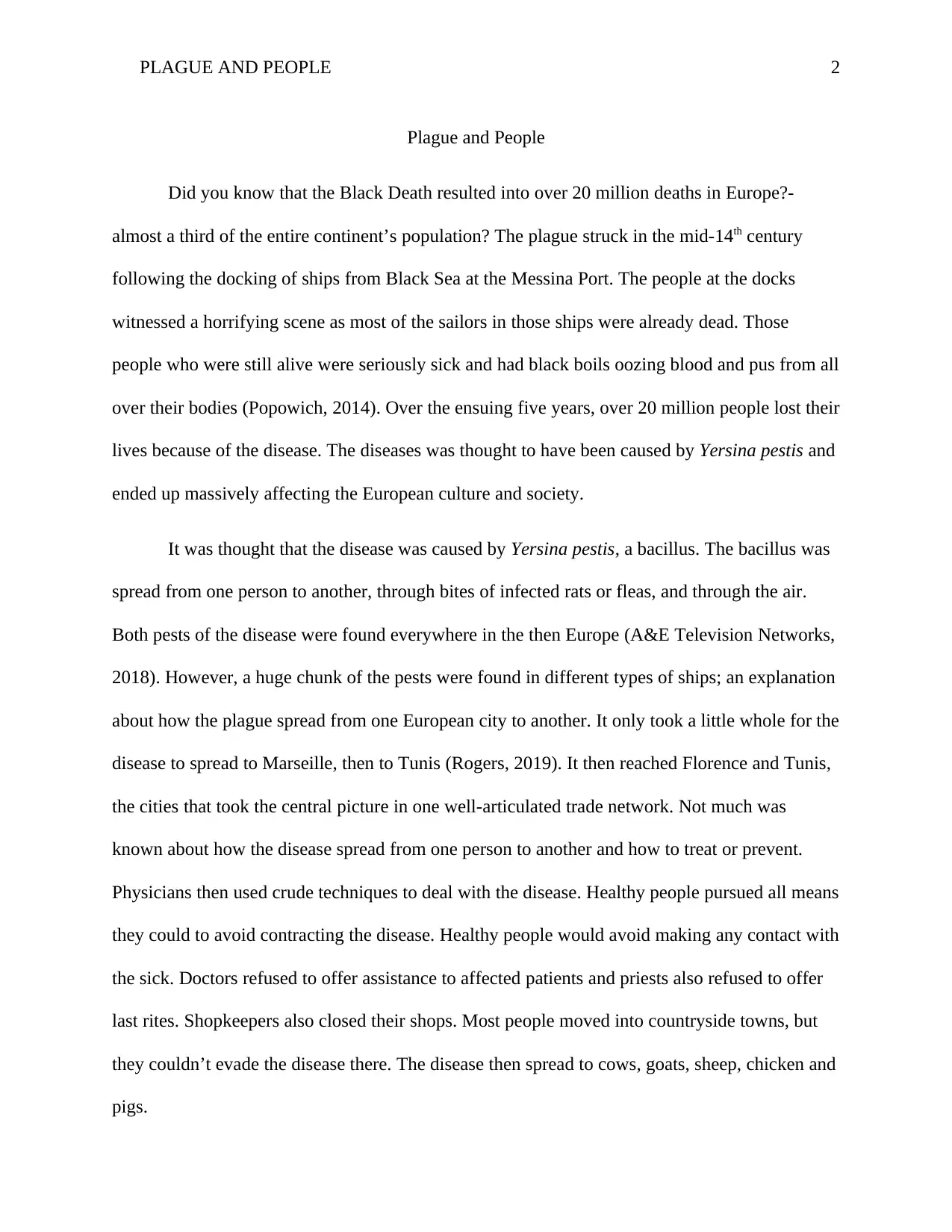
PLAGUE AND PEOPLE 2
Plague and People
Did you know that the Black Death resulted into over 20 million deaths in Europe?-
almost a third of the entire continent’s population? The plague struck in the mid-14th century
following the docking of ships from Black Sea at the Messina Port. The people at the docks
witnessed a horrifying scene as most of the sailors in those ships were already dead. Those
people who were still alive were seriously sick and had black boils oozing blood and pus from all
over their bodies (Popowich, 2014). Over the ensuing five years, over 20 million people lost their
lives because of the disease. The diseases was thought to have been caused by Yersina pestis and
ended up massively affecting the European culture and society.
It was thought that the disease was caused by Yersina pestis, a bacillus. The bacillus was
spread from one person to another, through bites of infected rats or fleas, and through the air.
Both pests of the disease were found everywhere in the then Europe (A&E Television Networks,
2018). However, a huge chunk of the pests were found in different types of ships; an explanation
about how the plague spread from one European city to another. It only took a little whole for the
disease to spread to Marseille, then to Tunis (Rogers, 2019). It then reached Florence and Tunis,
the cities that took the central picture in one well-articulated trade network. Not much was
known about how the disease spread from one person to another and how to treat or prevent.
Physicians then used crude techniques to deal with the disease. Healthy people pursued all means
they could to avoid contracting the disease. Healthy people would avoid making any contact with
the sick. Doctors refused to offer assistance to affected patients and priests also refused to offer
last rites. Shopkeepers also closed their shops. Most people moved into countryside towns, but
they couldn’t evade the disease there. The disease then spread to cows, goats, sheep, chicken and
pigs.
Plague and People
Did you know that the Black Death resulted into over 20 million deaths in Europe?-
almost a third of the entire continent’s population? The plague struck in the mid-14th century
following the docking of ships from Black Sea at the Messina Port. The people at the docks
witnessed a horrifying scene as most of the sailors in those ships were already dead. Those
people who were still alive were seriously sick and had black boils oozing blood and pus from all
over their bodies (Popowich, 2014). Over the ensuing five years, over 20 million people lost their
lives because of the disease. The diseases was thought to have been caused by Yersina pestis and
ended up massively affecting the European culture and society.
It was thought that the disease was caused by Yersina pestis, a bacillus. The bacillus was
spread from one person to another, through bites of infected rats or fleas, and through the air.
Both pests of the disease were found everywhere in the then Europe (A&E Television Networks,
2018). However, a huge chunk of the pests were found in different types of ships; an explanation
about how the plague spread from one European city to another. It only took a little whole for the
disease to spread to Marseille, then to Tunis (Rogers, 2019). It then reached Florence and Tunis,
the cities that took the central picture in one well-articulated trade network. Not much was
known about how the disease spread from one person to another and how to treat or prevent.
Physicians then used crude techniques to deal with the disease. Healthy people pursued all means
they could to avoid contracting the disease. Healthy people would avoid making any contact with
the sick. Doctors refused to offer assistance to affected patients and priests also refused to offer
last rites. Shopkeepers also closed their shops. Most people moved into countryside towns, but
they couldn’t evade the disease there. The disease then spread to cows, goats, sheep, chicken and
pigs.
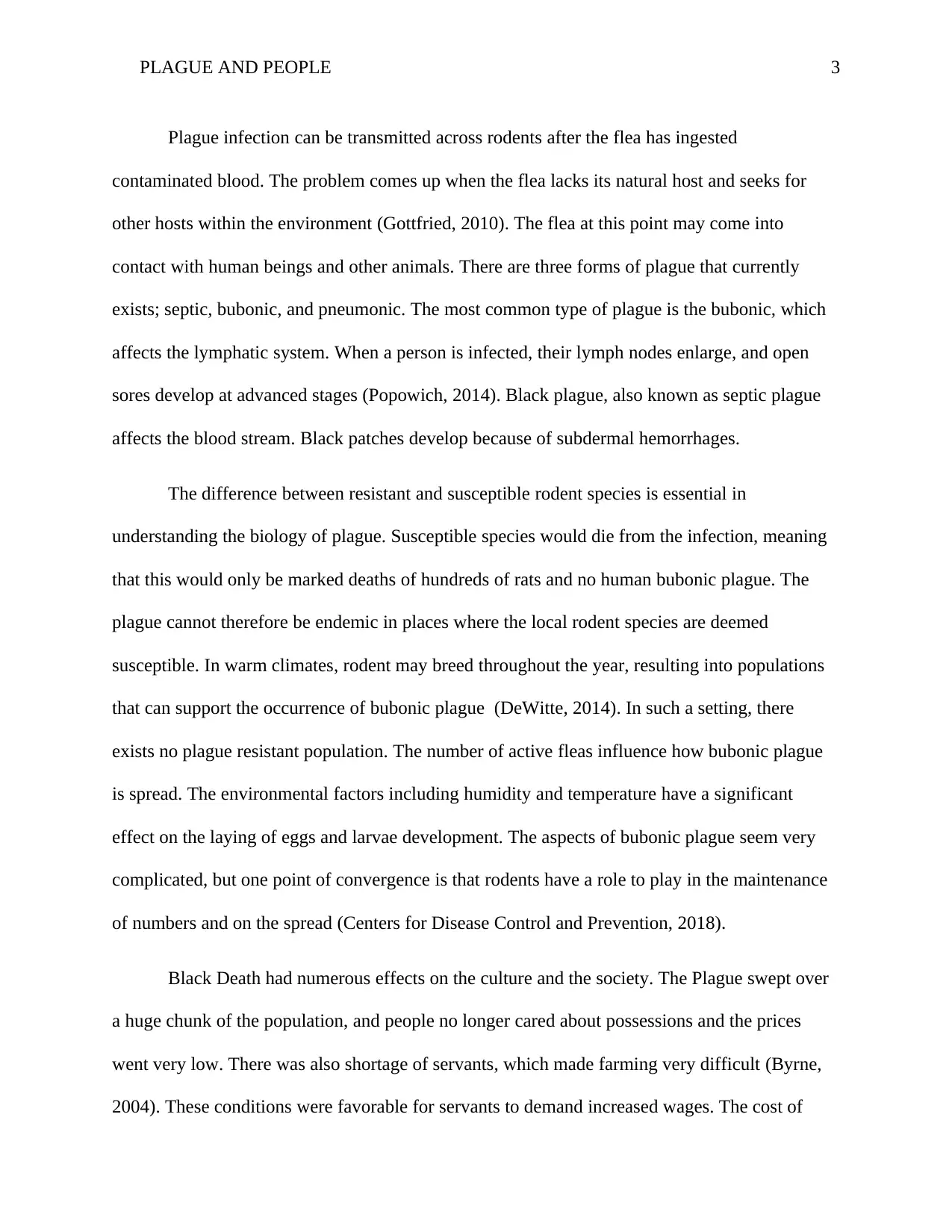
PLAGUE AND PEOPLE 3
Plague infection can be transmitted across rodents after the flea has ingested
contaminated blood. The problem comes up when the flea lacks its natural host and seeks for
other hosts within the environment (Gottfried, 2010). The flea at this point may come into
contact with human beings and other animals. There are three forms of plague that currently
exists; septic, bubonic, and pneumonic. The most common type of plague is the bubonic, which
affects the lymphatic system. When a person is infected, their lymph nodes enlarge, and open
sores develop at advanced stages (Popowich, 2014). Black plague, also known as septic plague
affects the blood stream. Black patches develop because of subdermal hemorrhages.
The difference between resistant and susceptible rodent species is essential in
understanding the biology of plague. Susceptible species would die from the infection, meaning
that this would only be marked deaths of hundreds of rats and no human bubonic plague. The
plague cannot therefore be endemic in places where the local rodent species are deemed
susceptible. In warm climates, rodent may breed throughout the year, resulting into populations
that can support the occurrence of bubonic plague (DeWitte, 2014). In such a setting, there
exists no plague resistant population. The number of active fleas influence how bubonic plague
is spread. The environmental factors including humidity and temperature have a significant
effect on the laying of eggs and larvae development. The aspects of bubonic plague seem very
complicated, but one point of convergence is that rodents have a role to play in the maintenance
of numbers and on the spread (Centers for Disease Control and Prevention, 2018).
Black Death had numerous effects on the culture and the society. The Plague swept over
a huge chunk of the population, and people no longer cared about possessions and the prices
went very low. There was also shortage of servants, which made farming very difficult (Byrne,
2004). These conditions were favorable for servants to demand increased wages. The cost of
Plague infection can be transmitted across rodents after the flea has ingested
contaminated blood. The problem comes up when the flea lacks its natural host and seeks for
other hosts within the environment (Gottfried, 2010). The flea at this point may come into
contact with human beings and other animals. There are three forms of plague that currently
exists; septic, bubonic, and pneumonic. The most common type of plague is the bubonic, which
affects the lymphatic system. When a person is infected, their lymph nodes enlarge, and open
sores develop at advanced stages (Popowich, 2014). Black plague, also known as septic plague
affects the blood stream. Black patches develop because of subdermal hemorrhages.
The difference between resistant and susceptible rodent species is essential in
understanding the biology of plague. Susceptible species would die from the infection, meaning
that this would only be marked deaths of hundreds of rats and no human bubonic plague. The
plague cannot therefore be endemic in places where the local rodent species are deemed
susceptible. In warm climates, rodent may breed throughout the year, resulting into populations
that can support the occurrence of bubonic plague (DeWitte, 2014). In such a setting, there
exists no plague resistant population. The number of active fleas influence how bubonic plague
is spread. The environmental factors including humidity and temperature have a significant
effect on the laying of eggs and larvae development. The aspects of bubonic plague seem very
complicated, but one point of convergence is that rodents have a role to play in the maintenance
of numbers and on the spread (Centers for Disease Control and Prevention, 2018).
Black Death had numerous effects on the culture and the society. The Plague swept over
a huge chunk of the population, and people no longer cared about possessions and the prices
went very low. There was also shortage of servants, which made farming very difficult (Byrne,
2004). These conditions were favorable for servants to demand increased wages. The cost of
⊘ This is a preview!⊘
Do you want full access?
Subscribe today to unlock all pages.

Trusted by 1+ million students worldwide
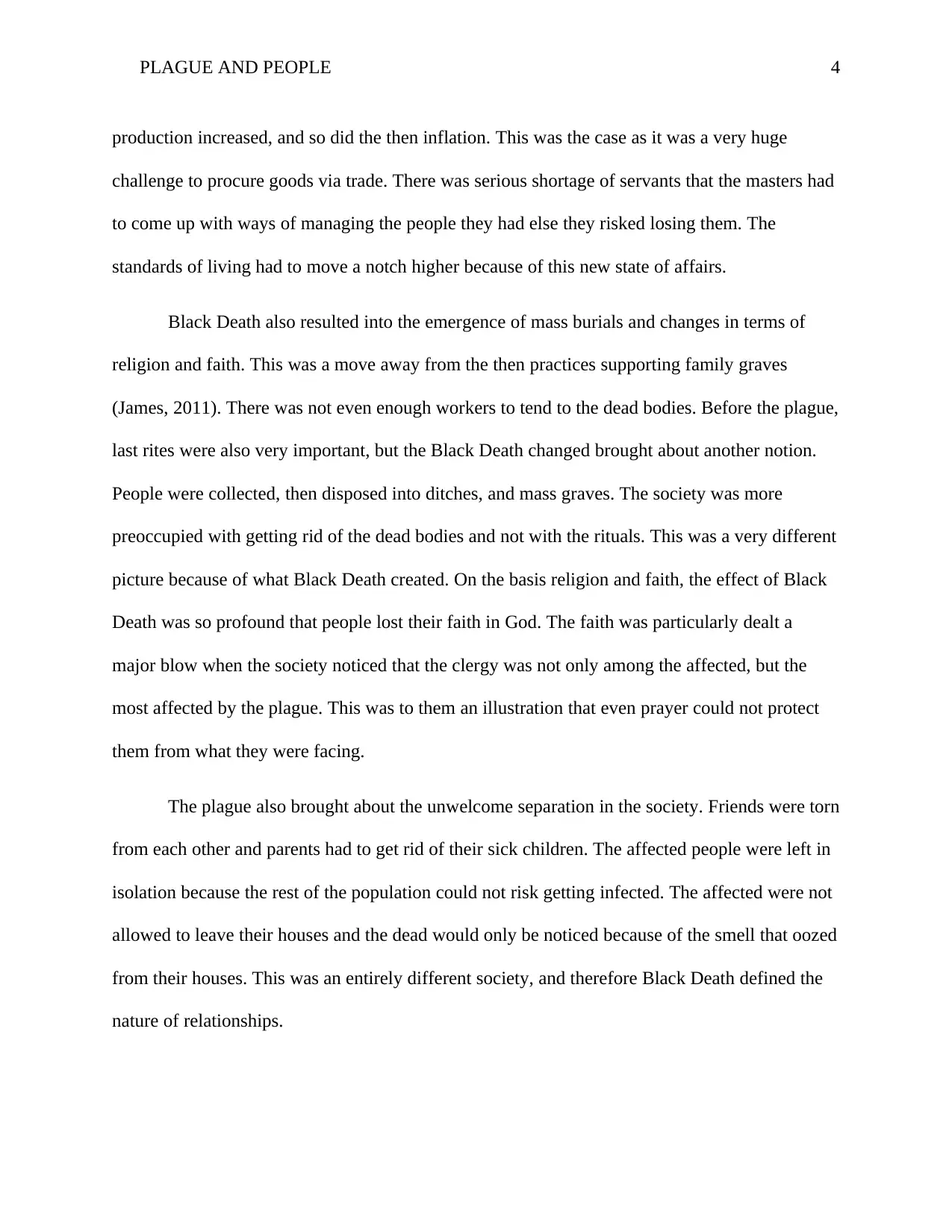
PLAGUE AND PEOPLE 4
production increased, and so did the then inflation. This was the case as it was a very huge
challenge to procure goods via trade. There was serious shortage of servants that the masters had
to come up with ways of managing the people they had else they risked losing them. The
standards of living had to move a notch higher because of this new state of affairs.
Black Death also resulted into the emergence of mass burials and changes in terms of
religion and faith. This was a move away from the then practices supporting family graves
(James, 2011). There was not even enough workers to tend to the dead bodies. Before the plague,
last rites were also very important, but the Black Death changed brought about another notion.
People were collected, then disposed into ditches, and mass graves. The society was more
preoccupied with getting rid of the dead bodies and not with the rituals. This was a very different
picture because of what Black Death created. On the basis religion and faith, the effect of Black
Death was so profound that people lost their faith in God. The faith was particularly dealt a
major blow when the society noticed that the clergy was not only among the affected, but the
most affected by the plague. This was to them an illustration that even prayer could not protect
them from what they were facing.
The plague also brought about the unwelcome separation in the society. Friends were torn
from each other and parents had to get rid of their sick children. The affected people were left in
isolation because the rest of the population could not risk getting infected. The affected were not
allowed to leave their houses and the dead would only be noticed because of the smell that oozed
from their houses. This was an entirely different society, and therefore Black Death defined the
nature of relationships.
production increased, and so did the then inflation. This was the case as it was a very huge
challenge to procure goods via trade. There was serious shortage of servants that the masters had
to come up with ways of managing the people they had else they risked losing them. The
standards of living had to move a notch higher because of this new state of affairs.
Black Death also resulted into the emergence of mass burials and changes in terms of
religion and faith. This was a move away from the then practices supporting family graves
(James, 2011). There was not even enough workers to tend to the dead bodies. Before the plague,
last rites were also very important, but the Black Death changed brought about another notion.
People were collected, then disposed into ditches, and mass graves. The society was more
preoccupied with getting rid of the dead bodies and not with the rituals. This was a very different
picture because of what Black Death created. On the basis religion and faith, the effect of Black
Death was so profound that people lost their faith in God. The faith was particularly dealt a
major blow when the society noticed that the clergy was not only among the affected, but the
most affected by the plague. This was to them an illustration that even prayer could not protect
them from what they were facing.
The plague also brought about the unwelcome separation in the society. Friends were torn
from each other and parents had to get rid of their sick children. The affected people were left in
isolation because the rest of the population could not risk getting infected. The affected were not
allowed to leave their houses and the dead would only be noticed because of the smell that oozed
from their houses. This was an entirely different society, and therefore Black Death defined the
nature of relationships.
Paraphrase This Document
Need a fresh take? Get an instant paraphrase of this document with our AI Paraphraser

PLAGUE AND PEOPLE 5
In conclusion, Black Death did indeed present massive scare on the basis of the numbers
that succumbed. The complex biology may explain why the disease swept such huge numbers.
The plague would proceed to massively affect the European culture and society.
In conclusion, Black Death did indeed present massive scare on the basis of the numbers
that succumbed. The complex biology may explain why the disease swept such huge numbers.
The plague would proceed to massively affect the European culture and society.
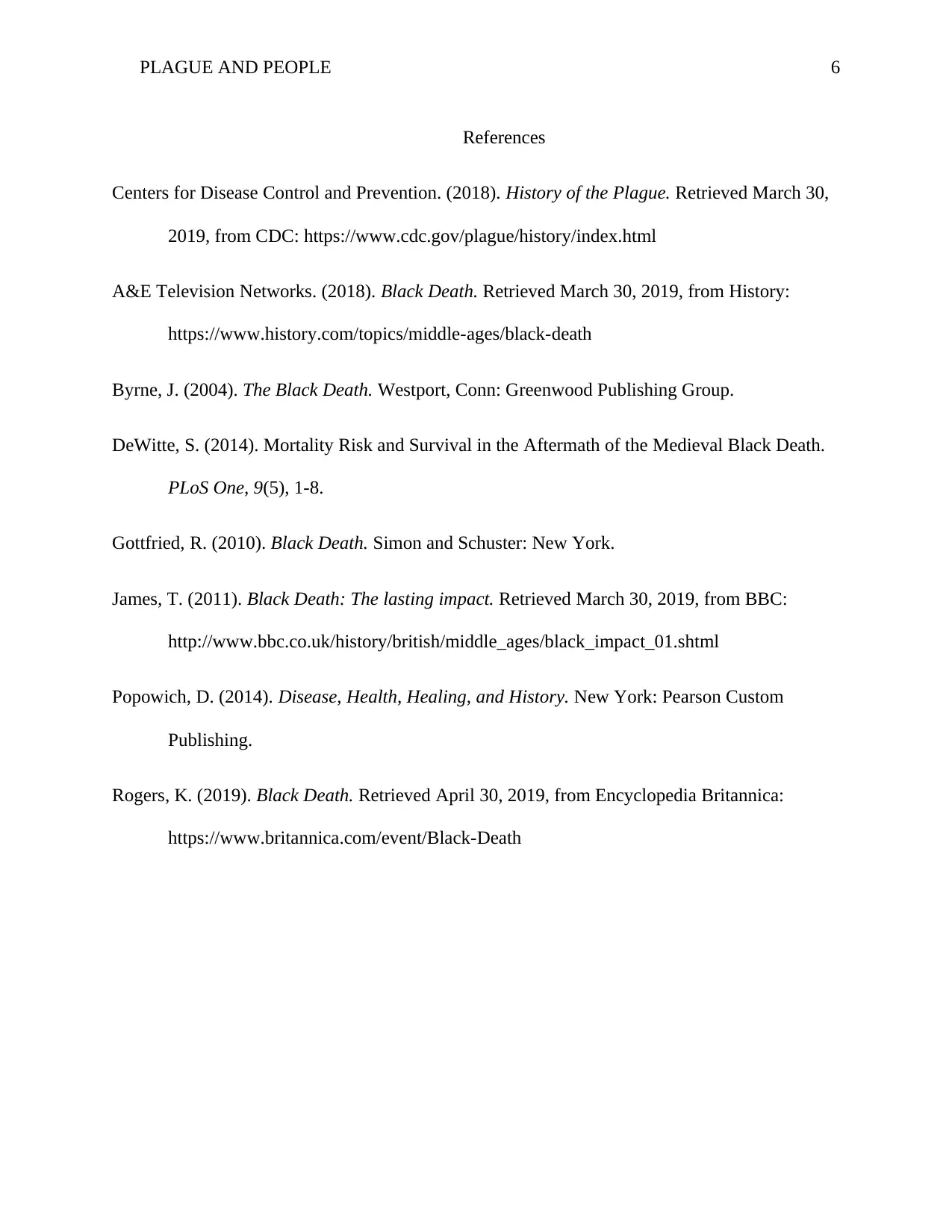
PLAGUE AND PEOPLE 6
References
Centers for Disease Control and Prevention. (2018). History of the Plague. Retrieved March 30,
2019, from CDC: https://www.cdc.gov/plague/history/index.html
A&E Television Networks. (2018). Black Death. Retrieved March 30, 2019, from History:
https://www.history.com/topics/middle-ages/black-death
Byrne, J. (2004). The Black Death. Westport, Conn: Greenwood Publishing Group.
DeWitte, S. (2014). Mortality Risk and Survival in the Aftermath of the Medieval Black Death.
PLoS One, 9(5), 1-8.
Gottfried, R. (2010). Black Death. Simon and Schuster: New York.
James, T. (2011). Black Death: The lasting impact. Retrieved March 30, 2019, from BBC:
http://www.bbc.co.uk/history/british/middle_ages/black_impact_01.shtml
Popowich, D. (2014). Disease, Health, Healing, and History. New York: Pearson Custom
Publishing.
Rogers, K. (2019). Black Death. Retrieved April 30, 2019, from Encyclopedia Britannica:
https://www.britannica.com/event/Black-Death
References
Centers for Disease Control and Prevention. (2018). History of the Plague. Retrieved March 30,
2019, from CDC: https://www.cdc.gov/plague/history/index.html
A&E Television Networks. (2018). Black Death. Retrieved March 30, 2019, from History:
https://www.history.com/topics/middle-ages/black-death
Byrne, J. (2004). The Black Death. Westport, Conn: Greenwood Publishing Group.
DeWitte, S. (2014). Mortality Risk and Survival in the Aftermath of the Medieval Black Death.
PLoS One, 9(5), 1-8.
Gottfried, R. (2010). Black Death. Simon and Schuster: New York.
James, T. (2011). Black Death: The lasting impact. Retrieved March 30, 2019, from BBC:
http://www.bbc.co.uk/history/british/middle_ages/black_impact_01.shtml
Popowich, D. (2014). Disease, Health, Healing, and History. New York: Pearson Custom
Publishing.
Rogers, K. (2019). Black Death. Retrieved April 30, 2019, from Encyclopedia Britannica:
https://www.britannica.com/event/Black-Death
⊘ This is a preview!⊘
Do you want full access?
Subscribe today to unlock all pages.

Trusted by 1+ million students worldwide
1 out of 6
Your All-in-One AI-Powered Toolkit for Academic Success.
+13062052269
info@desklib.com
Available 24*7 on WhatsApp / Email
![[object Object]](/_next/static/media/star-bottom.7253800d.svg)
Unlock your academic potential
Copyright © 2020–2025 A2Z Services. All Rights Reserved. Developed and managed by ZUCOL.


